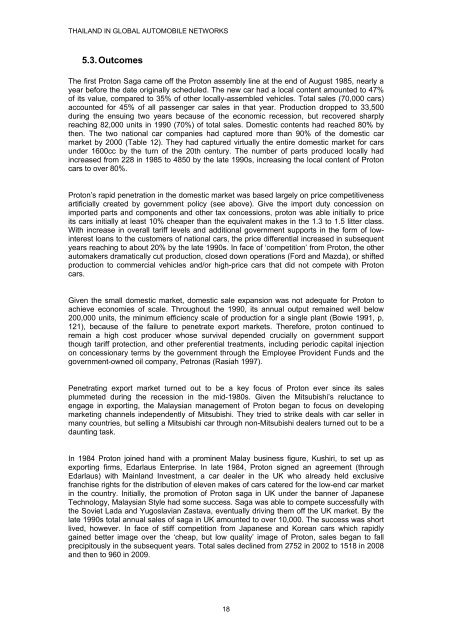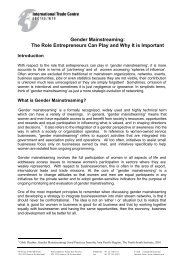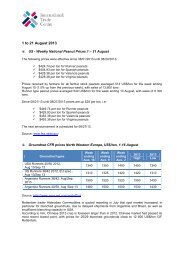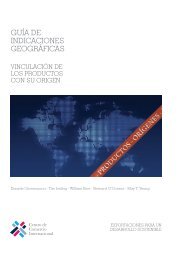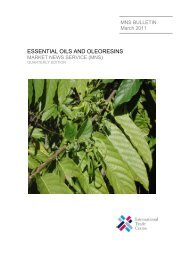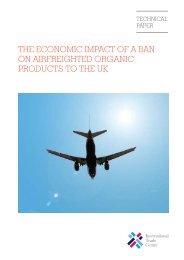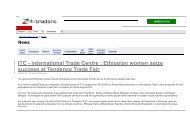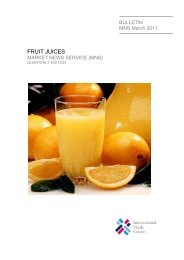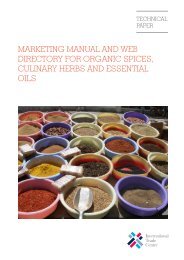thailand in global automobile networks - International Trade Centre
thailand in global automobile networks - International Trade Centre
thailand in global automobile networks - International Trade Centre
Create successful ePaper yourself
Turn your PDF publications into a flip-book with our unique Google optimized e-Paper software.
THAILAND IN GLOBAL AUTOMOBILE NETWORKS<br />
5.3. Outcomes<br />
The first Proton Saga came off the Proton assembly l<strong>in</strong>e at the end of August 1985, nearly a<br />
year before the date orig<strong>in</strong>ally scheduled. The new car had a local content amounted to 47%<br />
of its value, compared to 35% of other locally-assembled vehicles. Total sales (70,000 cars)<br />
accounted for 45% of all passenger car sales <strong>in</strong> that year. Production dropped to 33,500<br />
dur<strong>in</strong>g the ensu<strong>in</strong>g two years because of the economic recession, but recovered sharply<br />
reach<strong>in</strong>g 82,000 units <strong>in</strong> 1990 (70%) of total sales. Domestic contents had reached 80% by<br />
then. The two national car companies had captured more than 90% of the domestic car<br />
market by 2000 (Table 12). They had captured virtually the entire domestic market for cars<br />
under 1600cc by the turn of the 20th century. The number of parts produced locally had<br />
<strong>in</strong>creased from 228 <strong>in</strong> 1985 to 4850 by the late 1990s, <strong>in</strong>creas<strong>in</strong>g the local content of Proton<br />
cars to over 80%.<br />
Proton’s rapid penetration <strong>in</strong> the domestic market was based largely on price competitiveness<br />
artificially created by government policy (see above). Give the import duty concession on<br />
imported parts and components and other tax concessions, proton was able <strong>in</strong>itially to price<br />
its cars <strong>in</strong>itially at least 10% cheaper than the equivalent makes <strong>in</strong> the 1.3 to 1.5 litter class.<br />
With <strong>in</strong>crease <strong>in</strong> overall tariff levels and additional government supports <strong>in</strong> the form of low<strong>in</strong>terest<br />
loans to the customers of national cars, the price differential <strong>in</strong>creased <strong>in</strong> subsequent<br />
years reach<strong>in</strong>g to about 20% by the late 1990s. In face of ‘competition’ from Proton, the other<br />
automakers dramatically cut production, closed down operations (Ford and Mazda), or shifted<br />
production to commercial vehicles and/or high-price cars that did not compete with Proton<br />
cars.<br />
Given the small domestic market, domestic sale expansion was not adequate for Proton to<br />
achieve economies of scale. Throughout the 1990, its annual output rema<strong>in</strong>ed well below<br />
200,000 units, the m<strong>in</strong>imum efficiency scale of production for a s<strong>in</strong>gle plant (Bowie 1991, p,<br />
121), because of the failure to penetrate export markets. Therefore, proton cont<strong>in</strong>ued to<br />
rema<strong>in</strong> a high cost producer whose survival depended crucially on government support<br />
though tariff protection, and other preferential treatments, <strong>in</strong>clud<strong>in</strong>g periodic capital <strong>in</strong>jection<br />
on concessionary terms by the government through the Employee Provident Funds and the<br />
government-owned oil company, Petronas (Rasiah 1997).<br />
Penetrat<strong>in</strong>g export market turned out to be a key focus of Proton ever s<strong>in</strong>ce its sales<br />
plummeted dur<strong>in</strong>g the recession <strong>in</strong> the mid-1980s. Given the Mitsubishi’s reluctance to<br />
engage <strong>in</strong> export<strong>in</strong>g, the Malaysian management of Proton began to focus on develop<strong>in</strong>g<br />
market<strong>in</strong>g channels <strong>in</strong>dependently of Mitsubishi. They tried to strike deals with car seller <strong>in</strong><br />
many countries, but sell<strong>in</strong>g a Mitsubishi car through non-Mitsubishi dealers turned out to be a<br />
daunt<strong>in</strong>g task.<br />
In 1984 Proton jo<strong>in</strong>ed hand with a prom<strong>in</strong>ent Malay bus<strong>in</strong>ess figure, Kushiri, to set up as<br />
export<strong>in</strong>g firms, Edarlaus Enterprise. In late 1984, Proton signed an agreement (through<br />
Edarlaus) with Ma<strong>in</strong>land Investment, a car dealer <strong>in</strong> the UK who already held exclusive<br />
franchise rights for the distribution of eleven makes of cars catered for the low-end car market<br />
<strong>in</strong> the country. Initially, the promotion of Proton saga <strong>in</strong> UK under the banner of Japanese<br />
Technology, Malaysian Style had some success. Saga was able to compete successfully with<br />
the Soviet Lada and Yugoslavian Zastava, eventually driv<strong>in</strong>g them off the UK market. By the<br />
late 1990s total annual sales of saga <strong>in</strong> UK amounted to over 10,000. The success was short<br />
lived, however. In face of stiff competition from Japanese and Korean cars which rapidly<br />
ga<strong>in</strong>ed better image over the ‘cheap, but low quality’ image of Proton, sales began to fall<br />
precipitously <strong>in</strong> the subsequent years. Total sales decl<strong>in</strong>ed from 2752 <strong>in</strong> 2002 to 1518 <strong>in</strong> 2008<br />
and then to 960 <strong>in</strong> 2009.<br />
18


